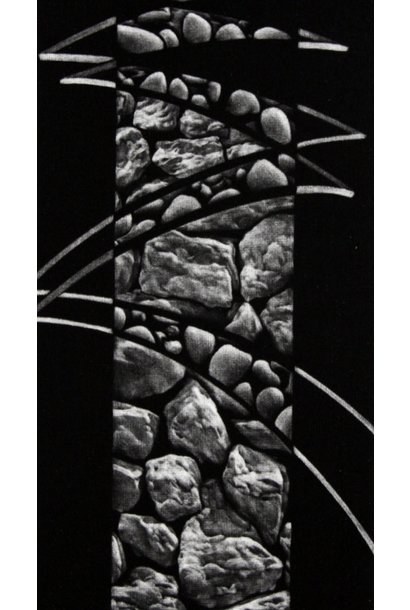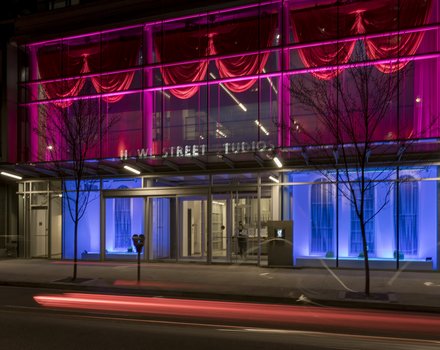

Masataka Kuroyanagi “Continuation / Accretion”, Masataka Kuroyanagi
C$ 0.00 Excl. tax
- File number: EXHI1009
...
Continuation / Accretion – Between Light & Darkness
In an age of digital image production, printmakers using traditional methods are forced to re-evaluate the merit of their craft, and whether it transcends the efficiency of new media. The mezzotints of Masataka Kuroyanagi are a testament to handcraft, commenting on the nature of time through dialogue between their production and visual content.
Mezzotint is a classical intaglio toning technique, in which the surface area of the plate is rocked in varying controlled directions. If rocked with experience and precision, the teeth of the plate will hold a rich and velvety surface of ink. The executionof the image entails the polishing down of these teeth with a burnishing tool, so they will hold less ink, creating light in a field of darkness. The technique was originally developed by German soldier Ludwig Von Siegen in the mid-17th century, and widely used throughout the eighteenth century as a method of reproducing and disseminating painted portraits. Kuroyanagi tends to subvert this original function by presenting his prints in the scale of paintings. His platesare also printed in very limited editions, rarefying rather than increasing their accessibility.
This need to push the boundaries, once having mastered a technique, manifests itself throughout Japan’s rich history of printmaking. Its presence can be traced through the increasing complexities of the Ukiyo-e (floating world) prints of the Edo period, to contemporary works utilizing plates of expandingscale and often multiple techniques. Kuroyanagi can be positioned alongside other contemporary Japanese printmakers, whose work is made to occupy ambitious spaces rather than the intimate viewing space of a traditional print.
A delicate sheet of tissue floatsin a sea of darkness. A scattering of stones is bathed bydim light. In a fast-paced world, the act of isolating and meditating on these quiet scenes speaks to Kuroyanagi of the fragility and ephemerality of life and passing time. This sense of slowing down in order to observe and process these moments is also reflected in the careful and lengthy nature of the mezzotint process. From the months of careful preparation: the physical labor of rocking his surfaces, the polishing, the printing, we reach the final image as a fragile scene informed by intense meditation and labor.
Many of thescenes include bundles of cloth orother material that seem to drift or curl in space. In certain works, these images are mirrored and reflected in the picture plane, transforming these surreal scenes into fractured and intricate patterns. Supernatural qualities become evident as the viewerperceives the absence of human presence in the scenes, where materials are often suspended as if by invisible hands.
Kuroyanagi’s most recent works depict highly rendered beds of pebbles and stones interrupted by bars and abstractions of dense darkness and color. Although these works depict weighted objects asopposed to airy material forms, they manifest a similar sense of fluidity as we are guided to the imposing darkness surrounding them. Kuroyanagi’s use of color is decidedly sparse and bold, serving to further clarify both the simplicities and complexities of his shadowed world.
The imagery of one specific new work, Two Papers, particularly highlights the aforementioned notion of time, in both its production and concept. The image depicts a tree, split down the center by a bar of darkness that is the negative space between two sheets of delicate paper. These papers are set in a larger square of mezzotinted darkness, and their lightly rendered creases double as both the illusion of surface, and of the background/ skyscape of the landscape. In this work, Kuroyanagi has fabricated a cycle that poetically links his imagery directly to his production. The viewer is faced with a physical sheet of paper, embossed with a perfect square of black ink (the result of intensive mezzotint rocking), and polished over this, the images of the papers and the tree: the genesis of the paper. At once these sheets become a background not onlyfor his landscape, but for all the prints he has created.
Kuroyanagi is the first to admit that his chosen medium has become dated,and is known to have been abandoned by noted graphic artists including M.C Escher, due to its complexity and taxing nature. In a contemporary world dominated by efficiency, the mezzotint is a rarely employed means of expression. It is not taught at most art institutions, as its proper execution would require an apprenticeship, rather than a semester.
In a recent artist statement, Kuroyanagi speaks of a twenty-year fascination with the medium, and of “images rising from the pitch-black darkness that presents a certain charm, that will never let (him) go.” When we are visually arrested by the dark stillness that Kuroyanagi presents to us, we begin to consider his monumental labor as less of a task and more of a necessity to his production. Inspired by these scenes, we begin to reflect on what more instant forms of image production might be lacking.
Jude Griebel



